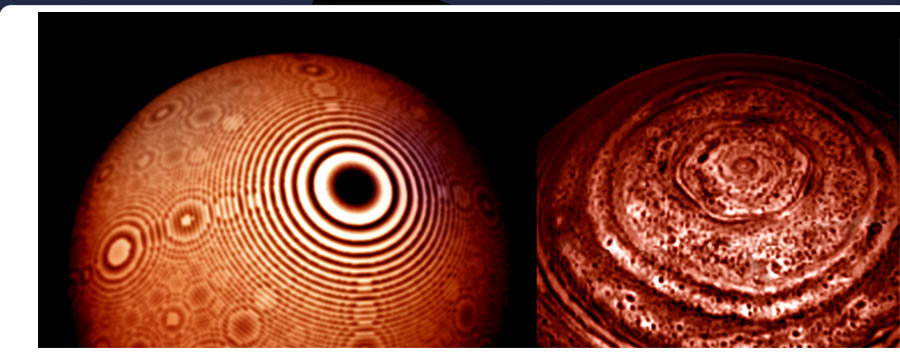Resonance in Saturn's Atmosphere
Saturn Hexagon Mystifies Scientists
by Larry O'Hanlon for Discovery News
March 27, 2007
Something downright weird has been sighted twirling over the north pole of Saturn: A long-lived double hexagon formed in the clouds.
The two six-sided features - one inside the other - are in stark contrast to the hurricane-like vortex that has been observed at the ringed planet's south pole. Both poles have been imaged by NASA's orbiting Cassini spacecraft.
"We haven't seen a (geometric) feature like this anywhere else on any other planet," said Cassini scientist Kevin Baines of the NASA's Jet Propulsion Laboratory. "It's unbelievable."
One of the unexplained hexagons was glimpsed obliquely before, by the Voyager 1 and 2 spacecrafts more than 20 years ago, which is how scientists know it's a durable feature. Cassini's infrared mapping instrument has provided the first whole, irrefutable images of the feature from a higher-latitude orbit.
The 15,000-mile-wide feature appears to be some sort of deep-seated standing wave, through which other things move without changing the wave pattern, Baines observed. It also appears to be in sync with the planet's quick 10-and-a-half-hour rotation.
Beyond that, nobody is sure what to make of it.
"It's perplexing," said Baines. "It's a bizarre pattern."
Cassini's recent fly over Saturn's southern hemisphere gave scientists a chance to verify that no such feature appears there. Instead there was a mega-hurricane-like vortex with a broad, deep eye over the south pole, explained Cassini team member Bob Brown of the University of Arizona.
The images of the nested hexagons were snapped in infrared light because Saturn's north pole is in darkness right now. In the images, the dark patches of clouds are obscuring the view of the warmer, and therefore infrared bright, gases below.
The advantage of infrared is that it allows scientists to see about 50 miles below the cool ammonia gas haze that makes Saturn look so deceptively quiet.
"Saturn's serene beauty is only skin deep," Baines told Discovery News.
Underneath, the planet appears to be as pocked and turbulent as giant Jupiter, he said. The reason for the difference is that Jupiter is warmer and has stronger gravity, which makes it hard for an ammonia haze to survive there, he explained.
The next good view of the hexagons is expected to be in about a year and a half, said Baines. That's when Cassini is scheduled to venture even further north. The sun will be shining on it then, which will allow scientists to see how the hexagon influences higher clouds that were invisible in the infrared images.
"We will have an even better view," Baines said of the next look. It's even possible that by that time someone will have come up with an explanation for the alien hexagons.
Analysis
Saturn's north polar hexagon, storm rings and south polar vortex are explainable as nonlinear standing wave resonances forming within the structure of Magnetic Resonance compared above and mathematically presented through this site.
The comparative image shows Cassini's false-color infrared imaging of Saturn at right and the Magnetic Resonance pattern at left to reveal the correlating symmetry of ringed Fibonacci banding.
The hexagonal infrasound standing wave resonance at Saturn's poles is direct evidence of a dodecahedral structure of magnetic field line distribution. Video recorded by Cassini quite clearly reveals the six-rayed alignment of Saturn's magnetic field.
The same resonance pattern also underlies the vortical storm activity on Jupiter, whose giant Red Spot was just joined by a smaller red companion vortex on April 8, 2006.
An identical comparison with the other gas planets reconfirms the correlation; in the ringed spectral shifts of Uranus and infrared imaging of Saturn's largest moon Titan.
This infrasound resonance pattern has also been observed for short periods on Earth and dictates the geopositions of the pyramids of the world, with the Orion pyramids of Giza, Egypt at the centerpoint.
The oncoming solar-system-wide magnetic reversal of December 22, 2012 may influence the atmospheric cloud patterns of Earth to become similar to those of Titan, with patterns of glowing plasma
forming in the skies - seen as brilliant luminous spots like standing aurora.





